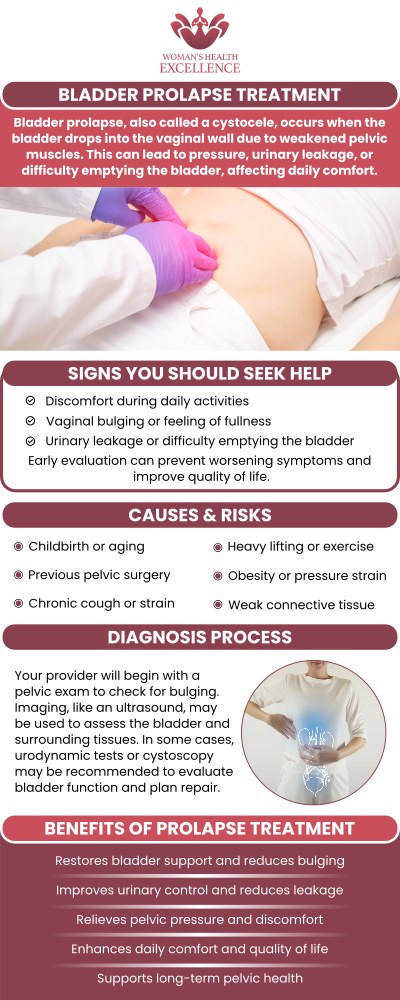Bladder Prolapse Treatment Specialist in Glendale, CA
The primary cause of bladder prolapse is the weakening of the pelvic floor muscles and connective tissues. This weakening can result from factors such as childbirth, aging, hormonal changes, obesity, chronic coughing, or repeated heavy lifting. The best treatment for a prolapsed bladder will depend on several variables. Dr. Prema Kothandaraman at the OB-Gyn & Incontinence Center will work with patients to determine the best course of action. Bladder prolapse treatment is available at the OB-Gyn & Incontinence Center. For more information contact us today or book an appointment online. Visit our clinics located in Glendale, CA, and Arcadia, CA.




Table of Contents:
What is the best treatment for a prolapsed bladder?
How serious is a prolapsed bladder?
When should you have surgery for a prolapsed bladder?
How long is recovery from bladder prolapse surgery?
The best treatment for a prolapsed bladder will depend on several variables. Staff at the OB-Gyn & Incontinence Center will work with patients to determine the best course of action. A physiotherapist can help stimulate and strengthen the pelvic floor muscles by using pelvic floor exercises and equipment. It would aim to relieve any discomfort and in mild cases, possibly cure the prolapse.
A mechanical device called a pessary is used for this purpose. As a result, the prolapse is ‘held up’ and symptoms are reduced. The pessaries do not cure prolapse; they simply control it while it is in place. The ring pessary is the most commonly used pessary, but there are other types as well.
Surgical repair of the pelvic floor is the most common form of surgery for prolapse. Pelvic floor repairs are described by this term. Priority is given to anterior vaginal repair and posterior vaginal repair to posterior vaginal repair. A hysterectomy can be performed if the uterus is prolapsing. You can re-suspend the top of your vagina if you’ve already undergone a hysterectomy.
A prolapsed bladder, or anterior vaginal prolapse, is caused by the bladder falling forward in the pelvis and pushing against the vaginal wall. It is usually the muscles and connective tissues of the pelvic floor that hold the organs of the pelvis in places, such as the bladder, uterus, and intestines. If the pelvic floor becomes weak or if it is put under too much pressure, anterior prolapse occurs. As a result of chronic constipation, violent coughing, or heavy lifting, this can occur over time, during vaginal childbirth, or during vaginal childbirth.
Prolapse of the anterior abdominal wall can be treated. Nonsurgical treatment is usually effective for mild or moderate prolapses. To maintain the proper position of the vagina and other pelvic organs in more severe cases, surgery may be necessary. There can be discomfort associated with a prolapsed bladder, but it is rarely painful. You may have difficulty emptying your bladder, which can lead to bladder infections. Any symptoms or signs that bother you or affect your daily life should be reported to your healthcare provider.
A woman with pelvic organ prolapse may only experience mild symptoms. The prolapse is usually treated with surgery only if it is affecting your daily life and if your doctor believes surgery will improve things.
Pelvic organ prolapse can be treated with a variety of surgeries. Depending on which organs have prolapsed, you will have a different type of surgery.
Consider surgery if you are in pain, experiencing bladder or bowel problems, or if the prolapse prevents you from enjoying your favorite activities.
It is possible for an organ to prolapse again after surgery. It is possible for surgery performed on one part of the pelvis to worsen a prolapse in another part. It is possible that you will need another surgery in the future.
Each day will bring you more strength and better health. The only downside is that you may get tired quickly and need pain medication for a week or two afterward. The recovery time from open surgery can range from 4 to 6 weeks, and laparoscopic surgery or vaginal surgery can range from 1 to 2 weeks.
During recovery, you should avoid heavy lifting, so that your incision can heal properly. A few days or a single overnight in the hospital is usually required. As soon as a woman’s bladder is emptying well, she can usually go home. A catheter may be necessary for a week or two in rare cases. You can still go home, but you will need to return in a week or two for the catheter to be removed.
Bladder prolapse treatment is available at the OB-Gyn & Incontinence Center. For more information contact us today or book an appointment online. Visit our clinics located in Glendale, CA, and Arcadia, CA. We serve patients from Arcadia CA, Glendale CA, West Covina CA, Whittier CA, Pasadena CA, Alhambra CA, and Baldwin Park CA.


Additional Services You May Need
▸ Urogynecology
▸ Minimally Invasive Gynecology
▸ Monalisa & Medical Aesthetics
▸ Bioidentical Hormone Replacement Therapy
▸ Urinary Incontinence
▸ Pelvic Organ Prolapse
▸ Painful Bladder
▸ Urinary Tract Infection
▸ Genitourinary Syndrome of Menopause
▸ Female Sexual Dysfunction
▸ Urinary Retention
▸ Vaginal Laxity & Prolapse
▸ Postpartum Pelvic Floor Problems
▸ PCOD
▸ Bladder Prolapse Repair
▸ Urgent PC
▸ Fibroids
▸ Excessive Bleeding
▸ Pelvic Pain
▸ Birth Control & IUD
▸ Vaginal & Pelvic Infection
▸ Monalisa Touch
▸ STD
▸ TempsureVitalia
▸ Biote Pellet Therapy
▸ Topical BHRT
▸ Flexsure
▸ Rectal Prolapse Repair
▸ Tempsure ENVI
▸ Minimally Invasive Pelvic Surgery for Incontinence



